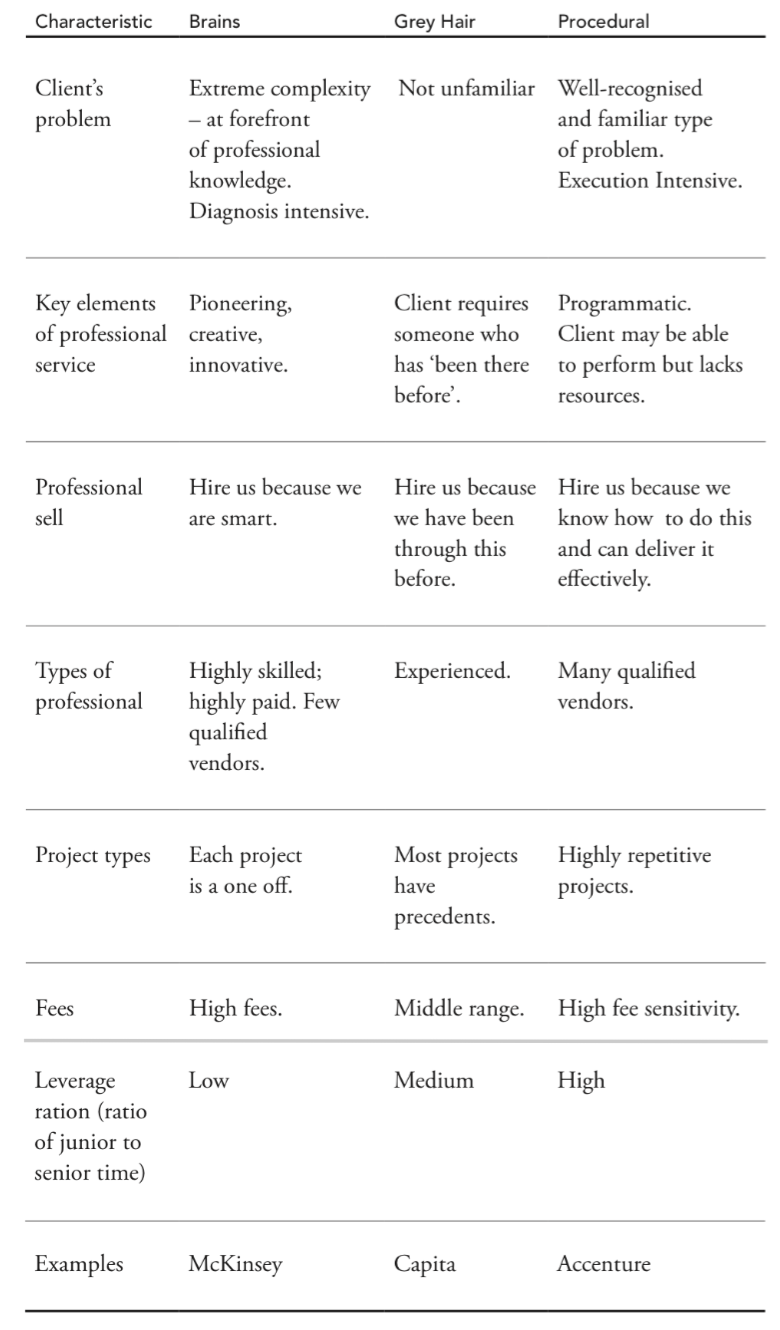Professional Service Leverage Models
Following on the series of business planning related blog posts (see ‘What a good business plan looks like?’, ‘Developing a Business Planning Process’, Some Business Planning ‘Top Tips’, Personal Case Study and Some Recommended Books), this post looks at the topic of leverage.
A future series of blog posts is going to look at ‘best practice’ models of organising a professional services firm. There is one aspect of professional service firm organisation, however, that is so fundamental to your forming growth plans that I need to cover it in detail here; it is the topic of leverage. As touched on in Guide 02, this is the factor that dictates the shape of your organisation – the ratio of junior, middle and senior staff in your firm.
As a prelude to a more detailed case study – we will now consider the basic leverage models for professional service firms. Regardless of the type of service you aim to provide, a premeditated consideration of your firm’s target leverage model is of critical importance to all aspects of your business planning.
This shape is primarily determined by the skill/experience requirements of the work that you typically undertake. There are three simple leverage model categories you may have heard reference to: Brains, Grey Hair and Procedural.
In the former (Brains), the client’s problem will be of an extremely technical, esoteric nature. A professional service business that operates under this model sells itself on the basis of exemplar technical competence; essentially, its message is ‘hire us, because we are smart’. Brain projects, commensurately, typically involve bespoke solutions developed by a few highly skilled (and paid) professionals. Whilst there may be some scope for junior-staff activity (data collection/analysis etc), the ratio of junior/middle-level-staff to senior-staff time tends to be very low.
Grey Hair projects conversely involve less one-off innovation; the general nature of the client issue is something that has been seen before by the firm’s staff even if some of the specifics are, invariably, unique. The client is seeking out a firm with relevant experience as opposed to super-smarts. A grey hair model requires the firm to sell its knowledge and client delivery track record; essentially its message to market is ‘hire us because we have done this before’. As there is a degree of pre-familiarity in this work, this model allows for more middle-level and junior staff into the leverage structure.
Finally, the Procedural project is one that involves a familiar client problem; the solution to which can be fairly systemised. Whilst they will still require bright people, these types of projects can be staffed by high numbers of juniors (who have learnt the procedures) under relatively light levels of senior supervision. An example of such a project might be the configuration, and roll-out, of an enterprise software solution. Essentially, its message to the market is ‘hire us, because we can deliver this effectively’. Such firms can be very highly leveraged.
As described in my Guide 02, one of your first important points of understanding is to assess what type of project work you seek to deliver. Economically, you should seek to make your firm as highly leveraged as realistic delegation can allow for – but no more. The challenge is to match an estimate of your typical clients’ need with the skills/experience available to you. To undershoot or overshoot on this is equally unwelcome. By example, the figure below shows these two consequences. In the first, the work is too procedural for the leverage structure in place; the consequence: an under utilisation of senior staff. In the second, there is a lack of qualified staff to undertake the work; the consequence: serious quality and client dissatisfaction issues are likely to arise.
So, getting this right is key at the planning stage. You should also consider this important topic through the lens of future joiners to your firm. Whilst there are many different ways of dividing up the grade levels there are always three broad classes as already touched on – senior, middle-level, junior. Or, to use common parlance, the ‘finders’, ‘minders’ and ‘grinders’ in the business.
Professional development and career progress in a professional service firm typically works on a craftsman–apprenticeship model with the senior ‘finders’ repaying the junior ‘grinders’ for their hard work by teaching them their craft. Junior and middle-level members will be willing to put in this effort in return for fulsome professional reward (client work, remuneration, training) in the moment and opportunities for promotion in the future. Your promotion regime, therefore, becomes a critical element of this leverage planning – especially so in relation to how long you see a typical member staying at each level, and, the probability of someone making the next. Clearly, promotion in a higher leveraged business (higher ratio of juniors to seniors) is going to be more competitive than in a lower leveraged business. I will cover promotion systems in more detail in my future Guide 12; suffice to say here that you need to strike the balance between (a) not promoting too quickly (as this can quickly damage your leverage shape and result in under-developed staff in critical client roles) and (b) not making the process so onerous that your best staff eventually seek more ascendant opportunities elsewhere. This is all part of the mix of leverage planning.
Finally, to reinforce the point, leverage is central to your profitability. The more you can do to deliver your services with a higher proportion of junior to senior staff, the lower your effective hourly rate is going to be (i.e. an efficiency you can pass onto your client) and the greater the profit per owner figure. In short, don’t skip the thinking, and planning, required to get this right!
In the next blog, I will look at a detailed, worked example of how such leverage planning sits at the centre of a well-formed business plan.
* As referenced in my Guide 02, this section owes much to David Maister and I borrow some terms he first penned in his excellent text (Managing the Professional Service Firm, 1997, Free Press).
————
If you are interested in re-charging your business ambition/strategy/plans, Dom runs his (three-day) Five-Year Entrepreneur Retreat twice a year (March, September) – see here for previous delegate testimonials and details on future presentations. If you would like to make a reservation (capped to 14 attendees per Retreat) please drop a line via the contact page.





